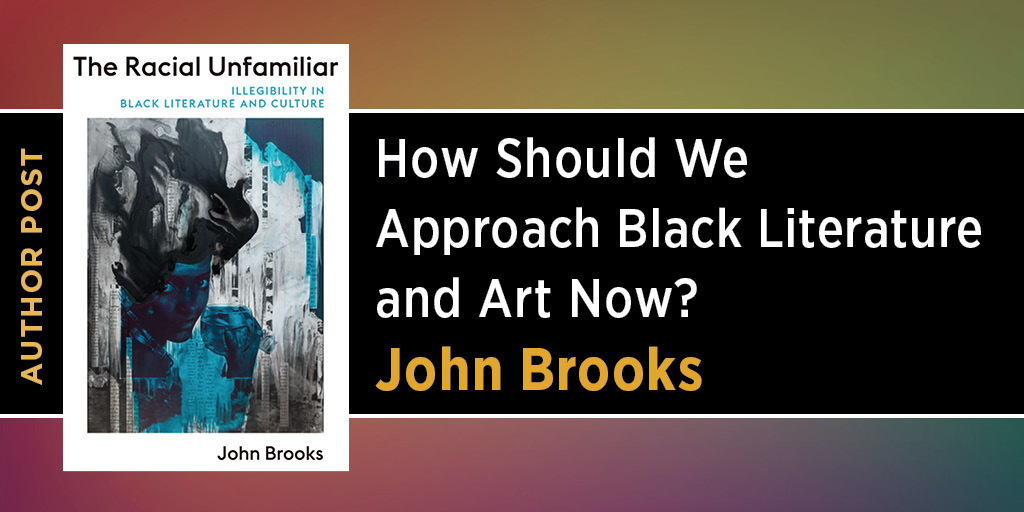How Should We Approach Black Literature and Art Now?
John Brooks

In the United States, there’s a tendency to assume that Black literature and art are valuable primarily because they’re pedagogical, as if Black creative expression exists first and foremost to educate racist whites. This approach may be well meaning, but it treats Black creative expression as a knowledge repository about Black life, inadvertently conceding that there is a fundamental and identifiable difference between Black people and people of other races.
For example, consider how book clubs and book reviewers often suggest that a Black author channels “the African American experience.” To make such a claim, one must first believe that some universal Black experience exists. The same pattern of thinking occurs when museum catalogs and exhibition announcements casually ask and answer the question “What does this artist say it really means to be Black?” The assumption is that there are specific behaviors or attitudes that determine whether someone really is “Black enough.” In both cases, the very discourses of racial difference that the pedagogical approach tries to resist come to (re)produce essentializing perspectives about Black life—even though, in reality, there are infinite ways that Black people live out and experience their Blackness.
Pedagogical approaches that reductively focus on the social information recorded in Black literature and art also heedlessly minimize the aesthetic qualities of Black expressive culture, not to mention the aesthetic experiences that it can deliver. For this reason, instead of asking what Black authors and artists intend to teach whites about “the African American experience,” one should consider the nature of the encounters that Black literature and art can create.
Encounters are important not just because they present something new to us but also because, when we accept their proposition, they reveal our sense of the world to be limited and contrived.
What can encounters elicit among audiences that lessons cannot? Encounters are important not just because they present something new to us but also because, when we accept their proposition, they reveal our sense of the world to be limited and contrived. Put another way, encounters are momentous not because they teach us the truth about racial identity or racial experience but because they underscore the absurdity of what people think they know to be capital-T “True” about race, in effect querying the very idea that any cultural assumptions about racial difference could be legitimate. In that sense, encounters are not for any one audience. Instead, encounters invite readers of any background to see—and participate in—the dismantling of the known world and the reimagining of it in new ways.
In The Racial Unfamiliar: Illegibility in Black Literature and Culture, I show how Black literature and art create encounters that are rich with this kind of conceptual confusion. Specifically, I examine how a group of contemporary Black authors and artists estrange historically entrenched ideas about Black life without providing any alternative ideas about how Blackness should be represented or regarded. These artists are expanding “what counts as Black” in radical, open-ended ways that are non-prescriptive and anti-essentialist. The mode of reading and analysis that I model in this book thus intervenes in traditional questions about positive/negative representations of Blackness with a different line of inquiry: How do contemporary Black artists confront cultural assumptions about race? How can familiar racial stereotypes be used to make race feel unfamiliar? What new self-reflective perspectives might emerge out of such disorienting encounters?
These questions are meant to signal a philosophical shift in how we read and comment on Black expressive culture. When someone suggests that an author channels “the African American experience” or asks “What does this artist say it really means to be Black?,” they invoke the Western philosophical tradition of epistemology, a field of inquiry concerned with the production, validity, and scope of knowledge. This philosophical tradition has normalized and empowered white supremacist views by treating racial groupings (which are social constructs) as naturally occurring, unchanging, knowable categories. I mean that racial epistemology has constructed the idea of Blackness through discourses of culture (which associate nonwhiteness with primitiveness), civility (which associate nonwhiteness with savagery), and rationality (which associate nonwhiteness with being unreasonable/backward), to name just three examples. By assuring people that racial groupings can be known according to certain attributes and associations, this philosophical tradition legitimates racial knowledge.
By assuring people that racial groupings can be known according to certain attributes and associations, this philosophical tradition legitimates racial knowledge.
In this mode of rationalist thinking, explanation precedes experience. When explanation precedes experience, it conditions how one can make sense of the world. The effects are all-encompassing: assumptions dictate how one thinks about race, preconceptions determine how one can see race, and suppositions shape how one can regard race. In summation, established racial knowledge renders Blackness intelligible only through stereotypical figurations.
The Racial Unfamiliar reverses this relationship. It shows how the friction of experiences—particularly embodied experiences like confusion, disorientation, and discomfort, as well as joy, relief, and pleasure—can call into question familiar but confining ideas about Black life. What is at stake in Black artists’ projects of epistemic unmaking, I argue, is not cultural correction, however “positive” various representations of Black life may appear. Rather, what is at stake is the power of illegibility to refute the idea that any universal Black experience or prescribed Black identity exists to be represented in literature or art.
By putting experience before knowledge, this mode of analysis returns us to the philosophical field of phenomenology. Phenomenology asks how we experience the world and how our subjective experiences compose the world. By this, I mean that phenomenologists see the body as a prism through which the world is experienced, so the body and its sensations are constitutive of all that can be known. It follows that immediate sensory experiences—like the feelings we have when we engage with Black literature and art—are a significant site for confronting and questioning the legitimacy of both explicitly racist ideas and general racial knowledge. Accordingly, we might think of a knotted feeling in the gut or butterflies in the stomach as visceral signs of an encounter that constitutes a primordial opening to the racist unconscious of normative thinking.
Phenomenological experiences drive ideas about race, not the other way around.
Why is it necessary to reinvest in phenomenological experience? Because rationalism is insufficient for challenging the racial knowledge that rationalism creates and justifies. When audiences approach Black literature and art epistemologically, they can only ask what Blackness is and is not. When audiences approach Black literature and art phenomenologically, they can ask what Blackness does and can do, including how it upends established patterns of thinking and how it opens onto new social possibilities.
And this philosophical shift is needed now. Indeed, the ongoing political drama around the purported teaching of critical race theory (CRT) provides a unique opportunity to reflect on how—and to what ends—we approach Black literature and art. As numerous state legislatures debate and pass bills seeking to ban discussions of race in K-12 classrooms (and, in some cases, in state-funded colleges and universities), the common refrain has become “it teaches students to hate America” or that “it says all white people are racist.” Some organizations (like the Heritage Foundation, a conservative Republican think tank) insist that discussions of race peddle racist ideas rather than address them.
These kinds of critiques assume a teacher–student relationship in which the former tells the latter what to think, in effect pushing their own opinions and hindering intellectual growth. In reality, CRT—and Black expressive culture more generally—produces phenomenological encounters in which students can negotiate the tension between the hegemonic society’s professed beliefs and the racial contract of the United States. Phenomenological experiences drive ideas about race, not the other way around.
To go the distance, it is necessary to dwell in and reflect on the discomforting experience of negotiating the incongruities between CRT data and democratic concepts like equality, freedom, and progress.
It’s not my intention to undervalue empirical research about the social realities of Black life. We need the statistics that Michelle Alexander shares in The New Jim Crow, which shows how the criminal justice system mobilized the “war on drugs” as a tool for the mass incarceration of Black men beginning in the 1960s and how a notion of colorblindness in the 1980s legitimized discrimination by erasing Black suffering. And we need Richard Rothstein’s The Color of Law, which uncovers how local, state, and federal laws following the Fair Housing Act of 1968 continued to reproduce conditions of racial segregation in neighborhoods across the country. There are many other examples, too. Mehrsa Baradaran lays bare the policies that preserve the racial wealth gap in The Color of Money and Carol Anderson explains how voting law continues to disenfranchise the Black electorate in One Person, No Vote. Even more recently, Harriet Washington’s A Terrible Thing to Waste shows how U.S. environmental policy leaves Black communities disproportionately vulnerable to atmospheric pollution, infectious disease, and industrial waste.
But knowing the statistics can only take us so far. To go the distance, it is necessary to dwell in and reflect on the discomforting experience of negotiating the incongruities between CRT data and democratic concepts like equality, freedom, and progress. Black literature and art stage these cultural incongruities, revealing such concepts to be propagandistic myths. For many audiences, particularly younger folks who may have diminishing faith in democratic concepts and institutions, navigating the tension between the data and the propaganda will be far more impactful than the statistics on their own.
This is why I advocate for putting less emphasis on the sociological lessons of Black literature and art and giving more consideration to the phenomenological encounters that they create. Rather than asking “What does this author/artist aim to teach whites about the African American experience?,” I see more transformative value in raising the question “How does this representation grate against what U.S. culture thinks it already knows, where did that ‘knowledge’ come from?” When we take this phenomenological approach, the ensuing ambiguities and incongruities will trouble our perception, haunt our assumptions, and upend our reasoning, creating the conditions in which new kinds of ideas might become sensible—but only if, when we feel the rupture taking hold, we accommodate ourselves to the illegibility of not knowing. Then, Black literature and art can produce an encounter that opens up the possibility of meeting the world in new ways.
John Brooks is a visiting assistant professor in the Department of Comparative Studies and the Department of Theatre, Film, and Media Arts at the Ohio State University. He is the author of The Racial Unfamiliar: Illegibility in Black Literature and Culture.





